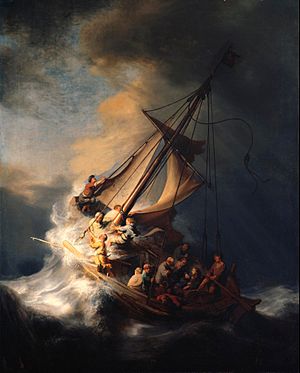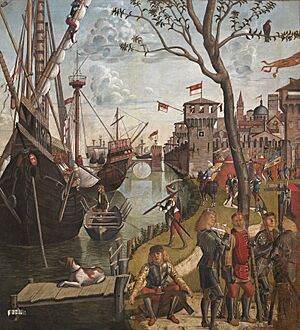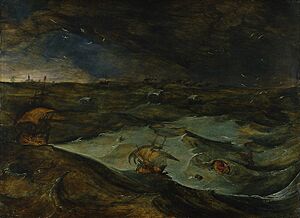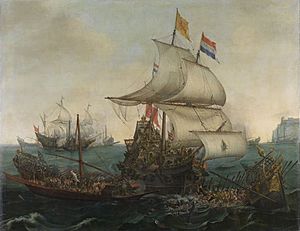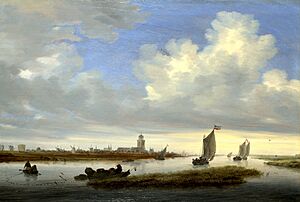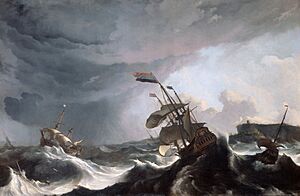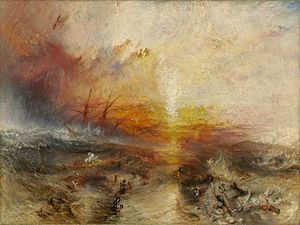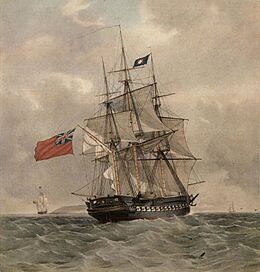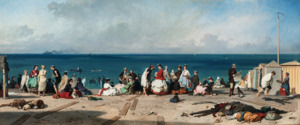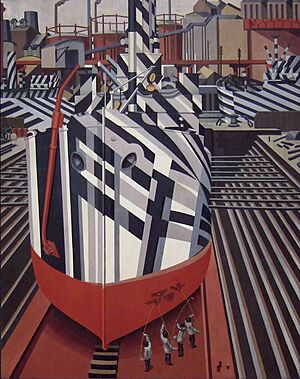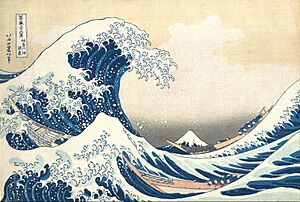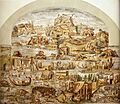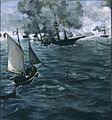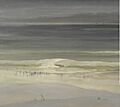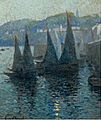Marine art facts for kids
Marine art is a type of art that shows the sea, ships, and everything connected to water. This includes paintings, drawings, sculptures, and prints. Artists get their ideas from oceans, rivers, and even beaches. Marine art became very popular from the 1600s to the 1800s. It often features boats, harbors, and beautiful coastlines. While 'maritime art' usually includes people or boats, 'marine art' can also show just the sea itself.

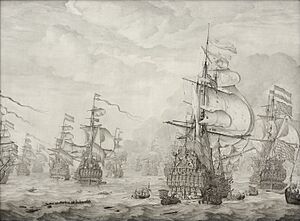
Contents
Ancient Boats and Early Art
People have drawn boats and water scenes for thousands of years! Some of the oldest rock carvings, called petroglyphs, are from 12,000 BCE in Gobustan, Azerbaijan. They show simple reed boats. Similar carvings of ships have been found on Greek islands, dating back to 4,000 BCE.
In Ancient Egyptian art, you can see people and gods on river "barges." Many boats were made from papyrus reeds. Pharaohs used expensive cedar boats, like the huge Khufu ship from around 2500 BCE. Egyptian tomb paintings often show hunting from boats on the Nile delta. Detailed boat models were even placed in tombs for the afterlife.
Ships sometimes appeared in Ancient Greek vase painting and on coins. Ancient Roman art often showed landscapes with calm lakes or bays. The large Nile mosaic of Palestrina from the 1st century BCE shows the entire Nile River.
During the Middle Ages, ships were shown in art when needed for stories. The 11th-century Bayeux Tapestry famously shows the Norman Invasion of England with many ships. Port seals from the 12th century often featured a "ship portrait." These images sometimes represented the church.
Early European Marine Art (1400s-1500s)
In the 1400s, marine art became more detailed in the Netherlands. Artists like Jan van Eyck created amazing miniatures showing the sea and weather. Illuminated manuscripts often featured realistic ships. Wealthy people also loved fancy metal sculptures called "nefs," shaped like ships.
Interest in ships grew through early prints. An artist known as Master W with the Key made some of the first detailed ship engravings. The first print of a naval battle was a huge woodcut of the Battle of Zonchio in 1499.
In Italian Renaissance art, Vittore Carpaccio from Venice often painted scenes of canals and docks.
In the 1500s, "world landscape" paintings became popular in the Netherlands, often including large areas of water. The Protestant Reformation led to more non-religious art, including landscapes and historical scenes featuring the sea.
Pieter Bruegel the Elder painted marine subjects, like Landscape with the Fall of Icarus (around 1568) and a large Naval Battle in the Gulf of Naples. The Anthony Roll was a special book made for King Henry VIII in the 1540s, listing Royal Navy ships.

Artists in the 1500s also started painting dramatic storms. As naval battles became more common, there was a greater demand for paintings showing these events. Artists focused on showing ships correctly.

The Golden Age of Dutch Marine Painting
The 1600s were a "Golden Age" for Dutch art, especially marine painting! The Dutch Republic was very wealthy due to sea trade and fishing. They also had many naval battles. Their country was full of rivers and canals, making sea and ship paintings incredibly popular.
Artists like Hendrick Cornelisz Vroom started painting from a lower viewpoint, making scenes feel more real. Many paintings showed Dutch ships flying their national flag. Artists often included land, like beaches or harbors, or views across wide rivers. Some, like Salomon van Ruysdael, specialized in river scenes.
Marine painting and landscape painting grew together, especially in how they showed the sky. Artists likely used detailed models of ships for accuracy.
The workshop of Willem van de Velde the Elder and his son, Willem van de Velde the Younger, became very famous. They focused on making the ship the main subject. In 1672, the Van de Veldes moved to London and painted for the English court. This left Ludolf Bakhuizen as a top marine artist in Amsterdam.
Reinier Nooms, a former sailor, was known for his accurate battle scenes and ship portraits. The Dutch style of marine art spread to other countries.
Most marine art was done by specialists. However, some famous artists, like Rembrandt, created powerful seascapes. His The Storm on the Sea of Galilee (1633) is his only true seascape. Claude Lorrain created beautiful harbor scenes.
The 1700s saw many naval battles, creating a big demand for exciting paintings. Many talented artists specialized in marine art, focusing on accurate ships. These were often commissioned by captains and ship-owners. Many artists had real experience at sea, like Nicholas Pocock, a former merchant captain.

Venetian artists Canaletto and Francesco Guardi painted beautiful cityscapes of Venice, often featuring canals and gondolas. Both were masters at capturing water and light.
Naval students learned drawing for new maps. Artists like John Thomas Serres taught at naval schools. Professional artists, such as William Hodges, traveled on voyages of exploration with people like James Cook. They brought back popular paintings of exotic coastal scenes.

French painter Claude Joseph Vernet was famous for his dramatic scenes of storms and shipwrecks. He also created a series of paintings showing French harbors. Watson and the Shark (1778) by John Singleton Copley is a famous marine history painting.
From Romanticism to Modern Marine Art
The Romantic period brought marine painting back into the main art world. Many artists still specialized in "ship portraits."
One of the most famous Romantic paintings is Théodore Géricault's The Raft of the Medusa (1819). For J. M. W. Turner, painting the sea was a lifelong passion. His works were like dramatic landscapes, often abstract, like Snow Storm – Steam-Boat off a Harbour's Mouth (1842).
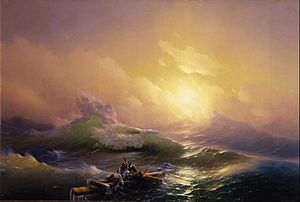
Russian artist Ivan Aivazovsky continued painting battles, shipwrecks, and storms with strong Romantic feelings, as in The Ninth Wave (1850). River, harbor, and coastal scenes were popular with artists like Jean-Baptiste-Camille Corot. Gustave Courbet painted many beach scenes. Édouard Manet painted important events, including the Battle of the Kearsarge and the Alabama (1864).
The "ship portrait" style came to America with artists like James E. Buttersworth. Winslow Homer focused on marine scenes with small boats in rough seas, like The Gulf Stream.
Later in the 1800s, coasts became places for fun. Beach scenes without ships became popular. The Impressionists painted many beaches, cliffs, and rivers. Claude Monet's painting Impression, Sunrise (1872) gave the Impressionist movement its name!
During World War I, British artist Sir Norman Wilkinson invented dazzle camouflage. Ships were painted with bold patterns to confuse enemy submarines.
Today, specialized marine painters still create ship portraits. Many people still prefer paintings of traditional sailing ships. Marine subjects continue to inspire many artists.
Marine Art in East Asia
In East Asian art, especially Chinese ink and brush paintings, rivers with small boats were common. Artists often focused on the land, leaving the water as white space. Some Chinese court paintings showed detailed scenes of ships on rivers, like in long scrolls depicting city life.
Popular Japanese ukiyo-e woodblock prints often featured coastal and river scenes with ships. The most famous example is The Great Wave off Kanagawa (1832) by Hokusai, which is known worldwide!
Images for kids
-
A Norman ship from the Bayeux Tapestry, 11th century.
-
A shipwreck drawing by Matthew Paris, 13th century.
-
Isabella of France lands at Harwich, 1455–60.
-
Gentile da Fabriano, a miracle of St Nicholas of Bari.
-
Woodcut of the Battle of Zonchio in 1499.
-
J. M. W. Turner. Calais Pier, 1803
-
Caspar David Friedrich, The Monk by the Sea, 1809
-
Caspar David Friedrich, The Stages of Life, 1835
-
Alexey Bogolyubov, Battle of Athos, 1853
-
Eugène Delacroix, Christ on the Sea of Galilee, 1854
-
Édouard Manet, Battle of the Kearsarge and the Alabama, 1864
-
James Abbott McNeill Whistler, Harmony in Blue and Silver:Trouville, 1865
-
Gustave Courbet, Autumn Sea, 1867
-
Gustave Courbet, The Waves, 1869
-
Albert Bierstadt, San Francisco Bay, 1871–1873
-
Hans Gude, Sailing into Oslo Fiord, 1872
-
Arkhip Kuindzhi, Lake Ladoga, 1873
-
Thomas Eakins, Starting Out After Rail, 1874
-
Pierre-Auguste Renoir, The Wave, 1879
-
Hendrik Willem Mesdag, Pinks in the breakers, c. 1880
-
Claude Monet, The Cliffs at Étretat, 1885
-
Eugène Boudin, Ships at Le Havre, 1887
-
Enrique Simonet, Venetian marine, 1887–1890
-
Winslow Homer, Sunlight on the Coast, 1890
-
Claude Monet, The Seine at Port-Villez, 1894
-
Isaac Levitan, Lake. Russia 1900
-
Camille Pissarro, Morning, Winter Sunshine, Frost, the Pont-Neuf, the Seine, the Louvre, Soleil D'hiver Gella Blanc, c. 1901
-
Winslow Homer, Summer Squall, 1904
-
Maurice de Vlaminck, The River Seine at Chatou, 1906
-
Paul Signac, Antibes, the towers, 1911
-
George Bellows, West Wind, 1913
-
Alexander Benois, On a deserted, wave-swept shore..., 1916


